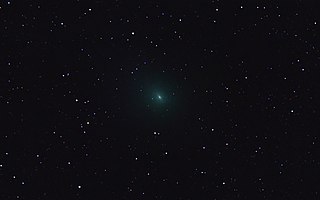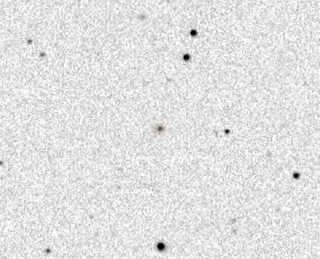Related Research Articles
The Minor Planet Center (MPC) is the official body for observing and reporting on minor planets under the auspices of the International Astronomical Union (IAU). Founded in 1947, it operates at the Smithsonian Astrophysical Observatory.
18610 Arthurdent (provisional designation 1998 CC2) is an asteroid from the middle region of the asteroid belt, approximately 3.5 kilometers in diameter. It was discovered on 7 February 1998, by a team of astronomers including Felix Hormuth at Starkenburg Observatory in Heppenheim, Germany. The asteroid was named after Arthur Dent from Douglas Adams's Hitchhiker's Guide to the Galaxy series.
Andrea Boattini is an Italian astronomer and a prolific discoverer of minor planets and comets.

45P/Honda–Mrkos–Pajdušáková is a short-period comet discovered by Minoru Honda December 3, 1948. It is named after Minoru Honda, Antonín Mrkos, and Ľudmila Pajdušáková. The object revolves around the Sun on an elliptical orbit with a period of 5.25 years. The nucleus is 1.3 kilometers in diameter. On August 19 and 20, 2011, it became the fifteenth comet detected by ground radar telescope.
27270 Guidotti (provisional designation 2000 AY4) is a carbonaceous background asteroid from the inner regions of the asteroid belt, approximately 7 kilometers in diameter. It was discovered on 2 January 2000, by Italian astronomers Luciano Tesi and Alfredo Caronia at the Pistoia Mountains Astronomical Observatory in San Marcello Pistoiese, Italy. The asteroid was named after amateur astronomer Guido Guidotti.
(523731) 2014 OK394 (provisional designation 1995 SN55) is a trans-Neptunian object that orbits in the outer Solar System beyond the orbit of Neptune. First observed as 1995 SN55 by Spacewatch on 20 September 1995, it was a lost minor planet with an insufficiently defined orbit with only 36 days of observations. On 8 October 2010, it was rediscovered by the Pan-STARRS 1 survey and later announced as 2014 OK394 in July 2016. It was not until November 2020 when amateur astronomers S. Deen and K. Ly identified 2014 OK394 and 1995 SN55 as the same object. This identification was confirmed and announced by the Minor Planet Center in January 2021.

440P/Kobayashi is a periodic comet in the Solar System, discovered by the Japanese amateur astronomer Takao Kobayashi on January 30, 1997. It was the first comet to be discovered by an amateur astronomer with the use of CCD.

332P/Ikeya–Murakami is a short-period comet with period of approximately 5.4 years first identified independently by the two Japanese amateur astronomers Kaoru Ikeya and Shigeki Murakami on November 3, 2010. Ikeya identified the comet using a 25-centimeter (10-inch) reflector at 39×, while Murakami used a 46 cm (18-inch) reflector at 78×. Photographic confirmation of the comet was obtained by Ernesto Guido and Giovanni Sostero using a Global-Rent-a-Scope (GRAS) telescope in New Mexico. Both Ikeya and Murakami discovered the comet using manual observation through optical telescopes. Such visual discoveries have become rare in recent years.

Comet C/2010 X1 (Elenin) is an Oort cloud comet discovered by Russian amateur astronomer Leonid Elenin on December 10, 2010, through remote control of the International Scientific Optical Network's robotic observatory near Mayhill in the U.S. state of New Mexico. The discovery was made using the automated asteroids discovery program CoLiTec. At the time of discovery, the comet had an apparent magnitude of 19.5, which made it about 150,000 times fainter than can be seen with the naked eye. The discoverer, Leonid Elenin, originally estimated that the comet nucleus was 3–4 km in diameter, but more recent estimates place the pre-breakup size of the comet at 2 km. Comet Elenin started disintegrating in August 2011, and as of mid-October 2011 was not visible even using large ground-based telescopes.
255P/Levy, formerly P/2006 T1 and P/2011 Y1, is a periodic comet with an orbital period of 5.25 years. It last came to perihelion on 14 January 2012. During the 2006 passage the comet achieved an apparent magnitude of ~9.5. Levy (PK06T010) was believed to have been recovered on 3 June 2011 at magnitude 19.8, but other observatories were unable to confirm a recovery. It was most likely a false positive because of large residuals. Levy was recovered on 17 December 2011 at magnitude 19.8, and given the second designation 2011 Y1. It was then numbered.
P/2011 NO1 (Elenin) is a periodic comet with a preliminary orbital period estimated at 13 ± 0.16 years. It came to perihelion (closest approach to the Sun) around 20 January 2011 at 1.2 AU from the Sun.
(523671) 2013 FZ27 (provisional designation 2013 FZ27) is a trans-Neptunian object located in the Kuiper belt in the outermost region of the Solar System, approximately 570 kilometers (350 miles) in diameter. It was discovered on 16 March 2013, by American astronomers Scott Sheppard and Chad Trujillo at the CTIO in Chile. Numbered in 2018, this minor planet has not been named.
Dmitry Nikolayevich Chestnov is a Russian astronomer, observer and photometrist of comets and discoverer of minor planets. He lives in Saransk, the capital city of the Republic of Mordovia, Russia.
(505478) 2013 UT15 is an extreme trans-Neptunian object from the scattered disc, located in the outermost regions of the Solar System, approximately 260 kilometers (160 miles) in diameter. It was discovered on 2 August 2013, by astronomers of the Outer Solar System Origins Survey at Mauna Kea Observatory, Hawaii, United States.
(457175) 2008 GO98, provisional designation 2008 GO98 with cometary number 362P, is a Jupiter family comet in a quasi-Hilda orbit within the outermost regions of the asteroid belt. It was discovered on 8 April 2008, by astronomers of the Spacewatch program at Kitt Peak National Observatory near Tucson, Arizona, in the United States. This presumably carbonaceous body has a diameter of approximately 15 kilometers (9 miles) and rotation period of 10.7 hours.
(501581) 2014 OB394, provisional designation 2014 OB394, is a trans-Neptunian object from the outermost region of the Solar System, approximately 260 kilometers (160 miles) in diameter. It was discovered on 25 August 2012, by astronomers with the Pan-STARRS survey at Haleakala Observatory, Hawaii, United States. The weak dwarf planet candidate was numbered in 2017 and remains without a name.
(501546) 2014 JJ80, prov. designation:2014 JJ80, is a trans-Neptunian object from the outermost region of the Solar System. It was discovered on 9 July 2013, by astronomers with the Pan-STARRS survey at Haleakala Observatory, Hawaii, United States. It is a dwarf planet candidate, as it measures approximately 350 kilometers (220 miles) in diameter.
(495603) 2015 AM281 (provisional designation 2015 AM281) is a resonant trans-Neptunian object in the outermost region of the Solar System, guesstimated at approximately 470 kilometers (290 miles) in diameter. It was discovered on 13 March 2010, by astronomers with the Pan-STARRS survey at Haleakala Observatory, Hawaii, United States.
2021 AV7 is a near-Earth asteroid of the Apollo group, discovered by astronomers Alain Maury and G. Attard at San Pedro de Atacama, Chile on 15 January 2021. With an estimated diameter of 450–1,000 m (1,480–3,280 ft), it is considered a potentially hazardous asteroid. It has a highly elliptical orbit that brings it within Earth's orbit. Although its nominal orbit has a small minimum orbit intersection distance around 70,000 km (43,000 mi) from Earth's orbital path, the asteroid does not make any close approaches within 0.2 astronomical units (30×106 km; 19×106 mi) over the next 100 years.
C/2021 J1 (Maury-Attard) is a Halley-type comet discovered on May 9, 2021, by French amateur astronomers Alain Maury and Georges Attard with the MAP (Maury/Attard/Parrott) observation program. It is the first comet discovered with the synthetic tracking technique, made possible with the Tycho Tracker commercial software developed by Daniel Parrott. When it was discovered, it had a magnitude of 19.
References
Citations
- ↑ MPC Circular of November 2, 2021. MPC-Circular.
- ↑ "New Comet P/2021 U3 (Attard-Maury)," Blog of Italian amateur astronomer Ernesto Guido. Guido-02112021.
- ↑ Alain Maury (November 1, 2021). "Discoveries of the MAP program" (in French). Alain Maury's Blog. BlogMaury-DecouvertesMap.
- ↑ "MPEC 2021-L11: COMET C/2021 J1 (Maury-Attard)". Minor Planet Center. June 2, 2021.
- ↑ MAP history and description, Alain Maury's blog. BlogMaury-MAP.
- 1 2 MPC Database, Minor Planet Center. MPC-Database.
- 1 2 3 SSD group's small bodies database at JPL. SSD.
- ↑ Orbit plot of P/2021 U3 (Attard-Maury), JPL SSD small bodies database.
Bibliography
- Ernesto Guido (November 2, 2021). "New Comet P/2021 U3 (Attard-Maury)". Blog of Italian amateur astronomer Ernesto Guido. Guido-02112021..




